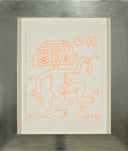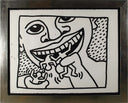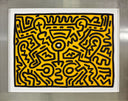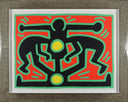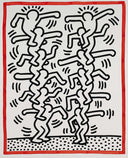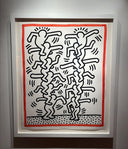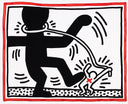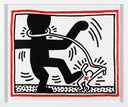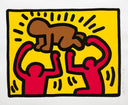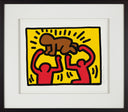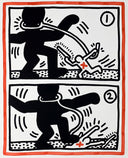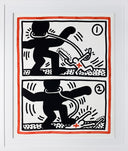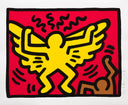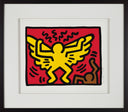Untitled (orange drawing), 1987
Details
Year: 1987
Sheet size: 18 x 15.5"
Image size: 18 x 15.5"
Framed size: 30 x 25.5"
Signature: signed 'K. Haring' lower left and dated '1987' lower right
About the Work
"Untitled (Orange Drawing)" is a hand-signed felt tip pen on paper drawing created by Keith Haring in 1987. The sheet size is 18 x 15.5" and the artwork is framed in a contemporary, closed-corner, gold leaf frame. The artwork ships framed and is accompanied by a certificate of authenticity.
Sporting a sideways hat and a ‘safe sex’ shirt of his own design, Haring is seen sitting on the floor of a dimly lit New York City nightclub, smiling and joking with his peers as his orange neon pen freely glides across the paper. In just under 3 minutes, Untitled emerges, a testament to Keith Haring’s masterful spontaneous technique. The speed and precision of Haring's hands, employing bold, seamless lines, intuitively bring to life the dancing boombox-headed figure. Vibrant energetic lines radiate from the figure’s body, creating the illusion of movement synchronized with the beat emanating from the figure’s head.
Haring's art was profoundly influenced by the rhythmic energy of the NYC club scene and street culture, including breakdancing and hip-hop. He sought to capture the raw energy and freedom inherent in these movements. His compositions, much like in Untitled, feature dancing figures with expressive gestures and dynamic lines evoking a feeling of rhythm and uninhibited freedom. This piece not only showcases Haring's technical prowess, but also his ability to convey the vivacity of urban life and culture through his art.
In the late 1970s and early 1980s, the boombox became a symbol of youth culture, urban identity and street life. It was also a metaphor for the spread of mass culture and the growing omnipresence of recorded sound. That sound was amplified by the rise of MTV, the Walkman, and electronic media, which blurred the lines between private listening and public performance. Haring was fascinated by how technology could both empower and dehumanize, turning people into vehicles of amplification and repetition.
His boombox-head figures often look celebratory — dancing or raising their arms — but they also carry a hint of critique: that in an era of mass broadcasting, individuality risks being drowned out. Haring’s boombox-headed figures convey both optimism about community as well as anxiety about mass culture – capturing a cultural moment when technology, music and identity were in flux. The fascination and the concern remain visually and conceptually relevant in today’s era of ubiquitous social media presence and 24-hour news cycles.
About the Artist
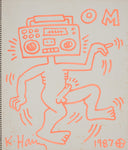
Untitled (orange drawing), 1987
MORE FROM THIS ARTIST
Start your collection with guidance you can trust
For nearly 50 years, we’ve helped new collectors find artwork they love and understand the stories behind each piece. Our gallery consultants offer personalized guidance, whether you’re exploring originals, limited editions, or discovering an artist for the first time. Visit your nearest gallery to start collecting with confidence.


Frequently Asked Questions
Your artwork comes with a Certificate of Authenticity (or Letter of Authenticity), professional packaging, and insured delivery.
We ship fully insured, using trusted carriers. Each piece is professionally packed to ensure safe arrival. Shipping times vary based on the location of the art, its destination, and whether or not it is framed (ready to ship) at the time of your purchase.
All our works come beautifully framed. Some print multiples may have framing options if we have unframed editions available in our warehouse. Our in-house framing provides high-quality moulding, acid-free materials and either UV plexiglass or framer’s grade acrylic. High value works may be framed in custom, closed-corner frames, and are often framed in Optium museum glass for enhanced clarity.
No, Martin Lawrence Galleries does not provide appraisal services. To ensure that appraisals are fully independent and unbiased, it is best practice for them to be carried out by certified appraisers who have not had prior involvement with the sale or handling of the artwork. For that reason, we do not appraise artworks that we handle, and instead recommend that collectors seek an independent, certified appraiser.
No, we own the vast majority of our inventory and do not seek out consignments from Sellers.
Yes, if you purchase from a local gallery, your consultant will be happy to assist you with hanging the artwork in your home.
Martin Lawrence Galleries has seven galleries across the country where you may be able to see the exact piece you are interested in. Print and sculpture multiples are more likely to be in several places for possible viewings whereas unique artworks will be constrained to one location. We are happy to facilitate your visit to one of our galleries if that is convenient for you. We can also take videos and extensive photos if a visit is not possible. Please contact us at martinlawrencegalleries.com.
We have over 50 years of experience, seven gallery locations across the United States, and a track record of connecting collectors with the right artwork.
No. Our consultants are here to guide you through the process, answer your questions, and make buying art simple and rewarding.
We encourage you to buy what you love. Our consultants will help you find the right piece that fits your taste and collection.
Please visit our page on specific instructions on how to take care of your artworks. Care Instructions
We stand by our artwork. Please review our detailed return policy here.


